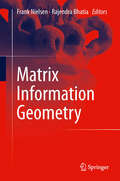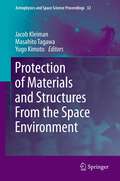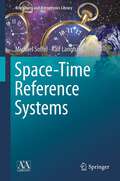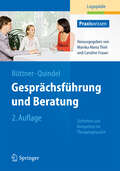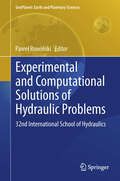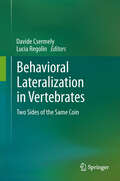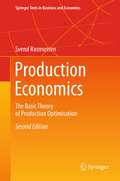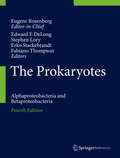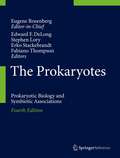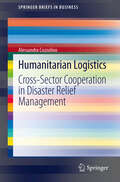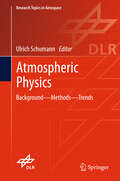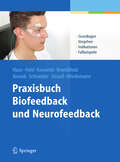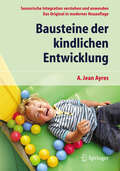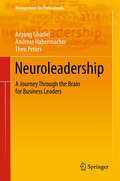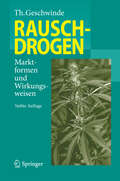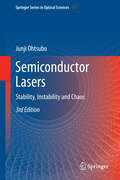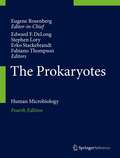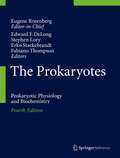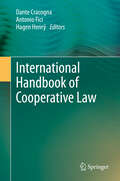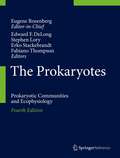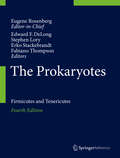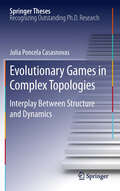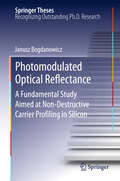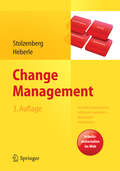- Table View
- List View
Matrix Information Geometry
by Rajendra Bhatia Frank NielsenThis book presents advances in matrix and tensor data processing in the domain of signal, image and information processing. The theoretical mathematical approaches are discusses in the context of potential applications in sensor and cognitive systems engineering. The topics and application include Information Geometry, Differential Geometry of structured Matrix, Positive Definite Matrix, Covariance Matrix, Sensors (Electromagnetic Fields, Acoustic sensors) and Applications in Cognitive systems, in particular Data Mining.
Protection of Materials and Structures From the Space Environment
by Jacob Kleiman Masahito Tagawa Yugo KimotoThe goals of the 10th International Space Conference on "Protection of Materials and Structures from Space Environment" ICPMSE-10J, since its inception in 1992, have been to facilitate exchanges between members of the various engineering and science disciplines involved in the development of space materials, including aspects of LEO, GEO and Deep Space environments, ground-based qualification, and in-flight experiments and lessons learned from operational vehicles that are closely interrelated to disciplines of the atmospheric sciences, solar-terrestrial interactions and space life sciences. The knowledge of environmental conditions on and around the Moon, Mars, Venus and the low Earth orbit as well as other possible candidates for landing such as asteroids have become an important issue, and protecting both hardware and human life from the effects of space environments has taken on a new meaning in light of the increased interest in space travel and colonization of other planets. And while many material experiments have been carried out on the ground and in open space in the last 50 years (LDEF, MEEP, SARE, MISSE, AOP, DSPSE, ESEM, EURECA, HST, MDIM, MIS, MPID, MPAC and SEED), many questions regarding the environmental impact of space on materials remain either poorly understood or unanswered. The coming generations of scientists will have to continue this work and tackle new challenges, continuing to build the level of confidence humans will need to continue the colonization of space. It is hoped that the proceedings of the ICPMSE-10J presented in this book will constitute a small contribution to doing so.
Space-Time Reference Systems
by Michael Soffel Ralf LanghansThe high accuracy of modern astronomical spatial-temporal reference systems has made them considerably complex. This book offers a comprehensive overview of such systems. It begins with a discussion of 'The Problem of Time', including recent developments in the art of clock making (e.g., optical clocks) and various time scales. The authors address the definitions and realization of spatial coordinates by reference to remote celestial objects such as quasars. After an extensive treatment of classical equinox-based coordinates, new paradigms for setting up a celestial reference system are introduced that no longer refer to the translational and rotational motion of the Earth. The role of relativity in the definition and realization of such systems is clarified. The topics presented in this book are complemented by exercises (with solutions). The authors offer a series of files, written in Maple, a standard computer algebra system, to help readers get a feel for the various models and orders of magnitude. Beyond astrometry, the main fields of application of high-precision astronomical spatial-temporal reference systems and frames are navigation (GPS, interplanetary spacecraft navigation) and global geodynamics, which provide a high-precision Celestial Reference System and its link to any terrestrial spatial-temporal reference system. Mankind's urgent environmental questions can only be answered in the context of appropriate reference systems in which both aspects, space and time, are realized with a sufficiently high level of accuracy. This book addresses all those interested in high-precision reference systems and the various techniques (GPS, Very Long Baseline Interferometry, Satellite Laser Ranging, Lunar Laser Ranging) necessary for their realization, including the production and dissemination of time signals.
Gesprächsführung und Beratung
by Ralf Quindel Claudia Büttner Monika RauschEine einfühlsame und zielorientierte Kommunikation mit Patienten und auch mit Eltern junger Patienten ist meistens ausschlaggebend für den Behandlungserfolg. In dem Buch kommen alle für die logopädische Therapie wichtigen Themen zur Sprache. Ausgehend von Grundbegriffen und Anwendungskonzepten vermitteln die Autoren Techniken der Gesprächsplanung sowie der Gesprächsführung und veranschaulichen diese anhand von Situationsbeispielen. Neu in der 2. Auflage sind u. a Abschnitte zur Elternberatung und zur interkulturellen Kommunikation.
Experimental and Computational Solutions of Hydraulic Problems
by Paweł RowińskiWhat is the progress in hydraulic research? What are the new methods used in modeling of transport of momentum, matter and heat in both open and conduit channels? What new experimental methods, instruments, measurement techniques, and data analysis routines are used in top class laboratory and field hydro-environment studies? How to link novel findings in fundamental hydraulics with the investigations of environmental issues? The consecutive 32nd International School of Hydraulics that took place in Łochów, Poland brought together eminent modelers, theoreticians and experimentalists as well as beginners in the field of hydraulics to consider these and other questions about the recent advances in hydraulic research all over the world. This volume reports key findings of the scientists that took part in the meeting. Both state of the art papers as well as detailed reports from various recent investigations are included in the book
Behavioral Lateralization in Vertebrates: Two Sides of the Same Coin
by Lucia Regolin Davide CsermelyFunctional lateralization in the human brain was first identified in the classic observations by Broca in the 19th century. Only one hundred years later, however, research on this topic began anew, discovering that humans share brain lateralization not only with other mammals, but with other vertebrates and even invertebrates. Studies on lateralization have also received considerable attention in recent years due to their important evolutionary implications, becoming an important and flourishing field of investigation worldwide among ethnologists and psychologists. The chapters of this book concern the emergence and adaptive function of lateralization in several aspects of behavior for a wide range of vertebrate taxa. These studies span from how lateralization affects some aspects of fitness in fishes, or how it affects the predatory and the exploratory behavior of lizards, to navigation in the homing flights of pigeons, social learning in chicks, the influence of lateralization on the ontogeny process of chicks, and the similarity of manual lateralization (handedness) between humans and apes, our closest relatives.
Production Economics
by Svend RasmussenThis book covers the basic theory of how, what and when firms should produce to maximise profits. Based on the neoclassical theory of the firm presented in most general microeconomic textbooks, it extends the general treatment and focuses on the application of the theory to specific problems that the firm faces when making production decisions to maximise profits. Increasing level of government regulation and the use of specialised and often very expensive equipment in modern production motivates the following focus areas: 1) How to optimise production under restrictions., 2) Treatment of fixed inputs and the process of input fixation, 3) Optimisation of production over time, 4) Linear and Mixed Integer Programming as tools for optimisation in practice. This updated second edition includes a more comprehensive introduction to the theory of decision making under risk and uncertainty as well as a new chapter on how to use linear programming to generate the supply function of the firm.
The Prokaryotes: Alphaproteobacteria and Betaproteobacteria
by Eugene Rosenberg Edward F. Delong Fabiano Thompson Stephen Lory Erko StackebrandtThe Prokaryotes is a comprehensive, multi-authored, peer reviewed reference work on Bacteria and Achaea. This fourth edition of The Prokaryotes is organized to cover all taxonomic diversity, using the family level to delineate chapters.<P><P> Different from other resources, this new Springer product includes not only taxonomy, but also prokaryotic biology and technology of taxa in a broad context. Technological aspects highlight the usefulness of prokaryotes in processes and products, including biocontrol agents and as genetics tools.<P><P> The content of the expanded fourth edition is divided into two parts: Part 1 contains review chapters dealing with the most important general concepts in molecular, applied and general prokaryote biology; Part 2 describes the known properties of specific taxonomic groups. Two completely new sections have been added to Part 1: bacterial communities and human bacteriology. The bacterial communities section reflects the growing realization that studies on pure cultures of bacteria have led to an incomplete picture of the microbial world for two fundamental reasons: the vast majority of bacteria in soil, water and associated with biological tissues are currently not culturable, and that an understanding of microbial ecology requires knowledge on how different bacterial species interact with each other in their natural environment. The new section on human microbiology deals with bacteria associated with healthy humans and bacterial pathogenesis. Each of the major human diseases caused by bacteria is reviewed, from identifying the pathogens by classical clinical and non-culturing techniques to the biochemical mechanisms of the disease process.<P> The 4th edition of The Prokaryotes is the most complete resource on the biology of prokaryotes.<P> The following volumes are published consecutively within the 4th Edition:<P> Prokaryotic Biology and Symbiotic Associations<P> Prokaryotic Communities and EcophysiologyProkaryotic Physiology and Biochemistry<P> Applied Bacteriology and Biotechnology<P> Human Microbiology<P> Actinobacteria<P> Firmicutes<P> Alphaproteobacteria and Betaproteobacteria<P> Gammaproteobacteria<P> Deltaproteobacteria and Epsilonproteobacteria<P> Other Major Lineages of Bacteria and the Archaea<P>
The Prokaryotes: Prokaryotic Biology, Communities and Ecophysiology
by Eugene Rosenberg Edward F. Delong Fabiano Thompson Stephen Lory Erko StackebrandtThe Prokaryotes is a comprehensive, multi-authored, peer reviewed reference work on Bacteria and Achaea. This fourth edition of The Prokaryotes is organized to cover all taxonomic diversity, using the family level to delineate chapters.<P><P> Different from other resources, this new Springer product includes not only taxonomy, but also prokaryotic biology and technology of taxa in a broad context. Technological aspects highlight the usefulness of prokaryotes in processes and products, including biocontrol agents and as genetics tools.<P><P> The content of the expanded fourth edition is divided into two parts: Part 1 contains review chapters dealing with the most important general concepts in molecular, applied and general prokaryote biology; Part 2 describes the known properties of specific taxonomic groups. Two completely new sections have been added to Part 1: bacterial communities and human bacteriology. The bacterial communities section reflects the growing realization that studies on pure cultures of bacteria have led to an incomplete picture of the microbial world for two fundamental reasons: the vast majority of bacteria in soil, water and associated with biological tissues are currently not culturable, and that an understanding of microbial ecology requires knowledge on how different bacterial species interact with each other in their natural environment. The new section on human microbiology deals with bacteria associated with healthy humans and bacterial pathogenesis. Each of the major human diseases caused by bacteria is reviewed, from identifying the pathogens by classical clinical and non-culturing techniques to the biochemical mechanisms of the disease process.<P> The 4th edition of The Prokaryotes is the most complete resource on the biology of prokaryotes.<P> The following volumes are published consecutively within the 4th Edition:<P> Prokaryotic Biology and Symbiotic Associations<P> Prokaryotic Communities and EcophysiologyProkaryotic Physiology and Biochemistry<P> Applied Bacteriology and Biotechnology<P> Human Microbiology<P> Actinobacteria<P> Firmicutes<P> Alphaproteobacteria and Betaproteobacteria<P> Gammaproteobacteria<P> Deltaproteobacteria and Epsilonproteobacteria<P> Other Major Lineages of Bacteria and the Archaea<P>
Humanitarian Logistics
by Alessandra CozzolinoHumanitarian logistics has received increasing interest both from logistics academics and practitioners as a result of the dramatic increase in both natural and man-made disasters. The impact on affected populations can be all the more limited as much as the logistics operations in response to emergencies are effective and efficient. Collaboration with various relevant actors involving in the emergency resolution can help to reduce costs, increase speed, and improve the leanness/agility level in the humanitarian supply chain, and viceversa, poor coordination among them is cited as an explanation for performance gaps. As disasters become increasingly complex better collaboration not only with government agencies, military units, humanitarian organizations, but also through partnerships with private business becomes more and more important. However, such partnerships are not easy as organizations in the two sectors are extremely different. The main aim of this study is exploring more in depth the partnership between profit and non-profit in emergency relief operations, with a specific attention to the cross-learning potential for both the logistics service provider (profit) and the humanitarian organization (non-profit).
Atmospheric Physics: Background – Methods – Trends (Research Topics in Aerospace)
by Ulrich SchumannOn the occasion of the 50th anniversary of the Institute of Atmospheric Physics of the German Aerospace Center (DLR), this book presents more than 50 chapters highlighting results of the institute's research.The book provides an up-to-date, in-depth survey across the entire field of atmospheric science, including atmospheric dynamics, radiation, cloud physics, chemistry, climate, numerical simulation, remote sensing, instruments and measurements, as well as atmospheric acoustics. The authors have provided a readily comprehensible and self-contained presentation of the complex field of atmospheric science. The topics are of direct relevance for aerospace science and technology. Future research challenges are identified.
Praxisbuch Biofeedback und Neurofeedback
by Manfred Nowak Karl-Michael Haus Andreas Krombholz Axel Kowalski Carla Held Edith Schneider Gert Strauß Meike WiedemannDie Behandlung mit Biofeedback und Neurofeedback beruht auf der Erkenntnis, dass die autonom innervierten Körperfunktionen wie z. B. Blutdruck oder Hirnströme durch Lernprozesse beeinflusst werden können. Die Autoren stellen in dem Praxisbuch alle wichtigen Bio- und Neurofeedbackverfahren vor: von der Funktionsweise bis zur Durchführung. Die vielseitigen Anwendungsmöglichkeiten in der Prävention und in der Therapie werden umfassend, anhand von Fallbeispielen und mit vielen Abbildungen vorgestellt. Mit knappen, übersichtlichen Praxisleitlinien.
Bausteine der kindlichen Entwicklung: Sensorische Integration verstehen und anwenden - Das Original in moderner Neuauflage
by A. Jean Ayres Elisabeth SoechtingKinder mit unterschiedlichen Entwicklungsstörungen werden seit Jahrzehnten mit Jean Ayres' Therapiekonzept erfolgreich behandelt. In dem Buch hat die US-Entwicklungspsychologin ihren Ansatz schlüssig und verständlich dargestellt. Die 5. Auflage wurde komplett aktualisiert und durch Fallgeschichten, Beispiele und Fotos noch anschaulicher gestaltet. Der Band richtet sich an Angehörige aller Berufsgruppen, die gesunde und lernbehinderte, verhaltensgestörte oder hirngeschädigte Kinder betreuen, eignet sich aber auch für Eltern und Familienangehörige.
Neuroleadership: A Journey Through the Brain for Business Leaders
by Theo Peters Argang Ghadiri Andreas HabermacherThis book takes you on a journey through the brain, its function and its impact on leadership. The young business field of neuroleadership is founded on the belief that understanding the brain can give leaders new and powerful insights into human behaviour and how to effectively tap into that knowledge to generate better returns in business. The book approaches the background, history, and major thinkers in the field, but also reassesses the fundamental concept of neuroleadership. The authors look into the fundamental basic needs of human beings, how they are represented in the neural networks, and how this manifests in motivational drives. The book also focuses explicitly on how impactful organisational tools can be from the viewpoint of the brain. By following this methodology, the reader will be able to use the knowledge of neuroscience at the workplace to better address individuals' brains and hence tap into the full power of brains in business.
Rauschdrogen
by Thomas GeschwindeDas Werk bietet grundlegende Informationen zu den Wirkungsweisen verschiedener Drogen. Die ausführliche Darstellung in Form eines Nachschlagewerks ermöglicht den Vergleich der jeweiligen Wirkungen. Neben "klassischen" Drogen wie Kokain werden in der Neuauflage auch vollsynthetische, ursprünglich für medizinische Therapien entwickelte Substanzen ausführlich behandelt. Ferner werden pflanzliche Stoffe, die über Online-Shops erhältlich sind, und "Lifestyle-Medikamente", die u. a. zur kognitiven Leistungssteigerung eingenommen werden, berücksichtigt.
Das italienische Zivilrecht in der Verfassungswirklichkeit: unter besonderer Berücksichtigung des europäischen Rechtsquellensystems
by Pietro PerlingieriLuca Di NellaIn dem Werk ist das gesamte italienische Zivilrecht dargestellt - unter besonderer Ber#65533;cksichtigung der italienischen Verfassung und des europ#65533;ischen Gemeinschaftsrechts. In klarer und gleichzeitig problem- und praxisbezogener Form stellt der Autor die einzelnen Rechtsinstitute vor und vermittelt die Techniken des Zivilrechts. Dabei arbeitet er heraus, dass das geltende Zivilrecht trotz des Pluralismus des Gemeinschaftsrechts immer noch Ausdruck einer Rechtsordnung ist, die von einheitlichen, in der Verfassung verankerten Grundwerten gepr#65533;gt ist.
Semiconductor Lasers
by Junji OhtsuboThis third edition of "Semiconductor Lasers, Stability, Instability and Chaos" was significantly extended. In the previous edition, the dynamics and characteristics of chaos in semiconductor lasers after the introduction of the fundamental theory of laser chaos and chaotic dynamics induced by self-optical feedback and optical injection was discussed. Semiconductor lasers with new device structures, such as vertical-cavity surface-emitting lasers and broad-area semiconductor lasers, are interesting devices from the viewpoint of chaotic dynamics since they essentially involve chaotic dynamics even in their free-running oscillations. These topics are also treated with respect to the new developments in the current edition. Also the control of such instabilities and chaos control are critical issues for applications. Another interesting and important issue of semiconductor laser chaos in this third edition is chaos synchronization between two lasers and the application to optical secure communication. One of the new topics in this edition is fast physical number generation using chaotic semiconductor lasers for secure communication and development of chaos chips and their application. As other new important topics, the recent advance of new semiconductor laser structures is presented, such as quantum-dot semiconductor lasers, quantum-cascade semiconductor lasers, vertical-cavity surface-emitting lasers and physical random number generation with application to quantum key distribution. Stabilities, instabilities, and control of quantum-dot semiconductor lasers and quantum-cascade lasers are important topics in this field.
The Prokaryotes: Human Microbiology
by Eugene Rosenberg Edward F. Delong Fabiano Thompson Stephen Lory Erko StackebrandtThe Prokaryotes is a comprehensive, multi-authored, peer reviewed reference work on Bacteria and Achaea. This fourth edition of The Prokaryotes is organized to cover all taxonomic diversity, using the family level to delineate chapters.<P><P> Different from other resources, this new Springer product includes not only taxonomy, but also prokaryotic biology and technology of taxa in a broad context. Technological aspects highlight the usefulness of prokaryotes in processes and products, including biocontrol agents and as genetics tools.<P><P> The content of the expanded fourth edition is divided into two parts: Part 1 contains review chapters dealing with the most important general concepts in molecular, applied and general prokaryote biology; Part 2 describes the known properties of specific taxonomic groups. Two completely new sections have been added to Part 1: bacterial communities and human bacteriology. The bacterial communities section reflects the growing realization that studies on pure cultures of bacteria have led to an incomplete picture of the microbial world for two fundamental reasons: the vast majority of bacteria in soil, water and associated with biological tissues are currently not culturable, and that an understanding of microbial ecology requires knowledge on how different bacterial species interact with each other in their natural environment. The new section on human microbiology deals with bacteria associated with healthy humans and bacterial pathogenesis. Each of the major human diseases caused by bacteria is reviewed, from identifying the pathogens by classical clinical and non-culturing techniques to the biochemical mechanisms of the disease process.<P> The 4th edition of The Prokaryotes is the most complete resource on the biology of prokaryotes.<P> The following volumes are published consecutively within the 4th Edition:<P> Prokaryotic Biology and Symbiotic Associations<P> Prokaryotic Communities and EcophysiologyProkaryotic Physiology and Biochemistry<P> Applied Bacteriology and Biotechnology<P> Human Microbiology<P> Actinobacteria<P> Firmicutes<P> Alphaproteobacteria and Betaproteobacteria<P> Gammaproteobacteria<P> Deltaproteobacteria and Epsilonproteobacteria<P> Other Major Lineages of Bacteria and the Archaea<P>
The Prokaryotes: Symbiosis and Human Microbiology
by Eugene Rosenberg Edward F. Delong Fabiano Thompson Stephen Lory Erko StackebrandtThe Prokaryotes is a comprehensive, multi-authored, peer reviewed reference work on Bacteria and Achaea. This fourth edition of The Prokaryotes is organized to cover all taxonomic diversity, using the family level to delineate chapters.<P><P> Different from other resources, this new Springer product includes not only taxonomy, but also prokaryotic biology and technology of taxa in a broad context. Technological aspects highlight the usefulness of prokaryotes in processes and products, including biocontrol agents and as genetics tools.<P><P> The content of the expanded fourth edition is divided into two parts: Part 1 contains review chapters dealing with the most important general concepts in molecular, applied and general prokaryote biology; Part 2 describes the known properties of specific taxonomic groups. Two completely new sections have been added to Part 1: bacterial communities and human bacteriology. The bacterial communities section reflects the growing realization that studies on pure cultures of bacteria have led to an incomplete picture of the microbial world for two fundamental reasons: the vast majority of bacteria in soil, water and associated with biological tissues are currently not culturable, and that an understanding of microbial ecology requires knowledge on how different bacterial species interact with each other in their natural environment. The new section on human microbiology deals with bacteria associated with healthy humans and bacterial pathogenesis. Each of the major human diseases caused by bacteria is reviewed, from identifying the pathogens by classical clinical and non-culturing techniques to the biochemical mechanisms of the disease process.<P> The 4th edition of The Prokaryotes is the most complete resource on the biology of prokaryotes.<P> The following volumes are published consecutively within the 4th Edition:<P> Prokaryotic Biology and Symbiotic Associations<P> Prokaryotic Communities and EcophysiologyProkaryotic Physiology and Biochemistry<P> Applied Bacteriology and Biotechnology<P> Human Microbiology<P> Actinobacteria<P> Firmicutes<P> Alphaproteobacteria and Betaproteobacteria<P> Gammaproteobacteria<P> Deltaproteobacteria and Epsilonproteobacteria<P> Other Major Lineages of Bacteria and the Archaea<P>
International Handbook of Cooperative Law
by Dante Cracogna Antonio Fici Hagen HenrÿThe degree of development reached by cooperatives of different sectors throughout the world, which among others led to the UN declaring 2012 as the International Year of Cooperatives, needs to be accompanied by a similar development of corresponding legislation. To this end, a better knowledge of cooperative law from the comparative point of view, as has already been established for other types of enterprises, becomes of great importance. This book strives to fill this gap, and is divided into four parts. The first part offers an analytic and conceptual framework with which to understand, study and assess cooperative law from a transnational and comparative perspective. The second part includes several chapters dealing with attempts to harmonize cooperative laws. The third part contains an overview of more than 30 national cooperative laws, while the last part summarizes and compares these national cooperative laws, thus laying the foundation for a comparative cooperative law doctrine.
The Prokaryotes: Prokaryotic Communities and Ecophysiology
by Eugene Rosenberg Edward F. Delong Fabiano Thompson Stephen Lory Erko StackebrandtThe Prokaryotes is a comprehensive, multi-authored, peer reviewed reference work on Bacteria and Achaea. This fourth edition of The Prokaryotes is organized to cover all taxonomic diversity, using the family level to delineate chapters.<P><P> Different from other resources, this new Springer product includes not only taxonomy, but also prokaryotic biology and technology of taxa in a broad context. Technological aspects highlight the usefulness of prokaryotes in processes and products, including biocontrol agents and as genetics tools.<P><P> The content of the expanded fourth edition is divided into two parts: Part 1 contains review chapters dealing with the most important general concepts in molecular, applied and general prokaryote biology; Part 2 describes the known properties of specific taxonomic groups. Two completely new sections have been added to Part 1: bacterial communities and human bacteriology. The bacterial communities section reflects the growing realization that studies on pure cultures of bacteria have led to an incomplete picture of the microbial world for two fundamental reasons: the vast majority of bacteria in soil, water and associated with biological tissues are currently not culturable, and that an understanding of microbial ecology requires knowledge on how different bacterial species interact with each other in their natural environment. The new section on human microbiology deals with bacteria associated with healthy humans and bacterial pathogenesis. Each of the major human diseases caused by bacteria is reviewed, from identifying the pathogens by classical clinical and non-culturing techniques to the biochemical mechanisms of the disease process.<P> The 4th edition of The Prokaryotes is the most complete resource on the biology of prokaryotes.<P> The following volumes are published consecutively within the 4th Edition:<P> Prokaryotic Biology and Symbiotic Associations<P> Prokaryotic Communities and EcophysiologyProkaryotic Physiology and Biochemistry<P> Applied Bacteriology and Biotechnology<P> Human Microbiology<P> Actinobacteria<P> Firmicutes<P> Alphaproteobacteria and Betaproteobacteria<P> Gammaproteobacteria<P> Deltaproteobacteria and Epsilonproteobacteria<P> Other Major Lineages of Bacteria and the Archaea<P>
The Prokaryotes: Firmicutes and Tenericutes
by Eugene Rosenberg Edward F. Delong Fabiano Thompson Stephen Lory Erko StackebrandtThe Prokaryotes is a comprehensive, multi-authored, peer reviewed reference work on Bacteria and Achaea. This fourth edition of The Prokaryotes is organized to cover all taxonomic diversity, using the family level to delineate chapters.<P><P> Different from other resources, this new Springer product includes not only taxonomy, but also prokaryotic biology and technology of taxa in a broad context. Technological aspects highlight the usefulness of prokaryotes in processes and products, including biocontrol agents and as genetics tools.<P><P> The content of the expanded fourth edition is divided into two parts: Part 1 contains review chapters dealing with the most important general concepts in molecular, applied and general prokaryote biology; Part 2 describes the known properties of specific taxonomic groups. Two completely new sections have been added to Part 1: bacterial communities and human bacteriology. The bacterial communities section reflects the growing realization that studies on pure cultures of bacteria have led to an incomplete picture of the microbial world for two fundamental reasons: the vast majority of bacteria in soil, water and associated with biological tissues are currently not culturable, and that an understanding of microbial ecology requires knowledge on how different bacterial species interact with each other in their natural environment. The new section on human microbiology deals with bacteria associated with healthy humans and bacterial pathogenesis. Each of the major human diseases caused by bacteria is reviewed, from identifying the pathogens by classical clinical and non-culturing techniques to the biochemical mechanisms of the disease process.<P> The 4th edition of The Prokaryotes is the most complete resource on the biology of prokaryotes.<P> The following volumes are published consecutively within the 4th Edition:<P> Prokaryotic Biology and Symbiotic Associations<P> Prokaryotic Communities and EcophysiologyProkaryotic Physiology and Biochemistry<P> Applied Bacteriology and Biotechnology<P> Human Microbiology<P> Actinobacteria<P> Firmicutes<P> Alphaproteobacteria and Betaproteobacteria<P> Gammaproteobacteria<P> Deltaproteobacteria and Epsilonproteobacteria<P> Other Major Lineages of Bacteria and the Archaea<P>
Evolutionary Games in Complex Topologies
by Julia Poncela CasasnovasThere are many examples of cooperation in Nature: cells cooperate to form tissues, organs cooperate to form living organisms, and individuals cooperate to raise their offspring or to hunt. However, why cooperation emerges and survives in hostile environments, when defecting would be a much more profitable short-term strategy, is a question that still remains open. During the past few years, several explanations have been proposed, including kin and group selection, punishment and reputation mechanisms, or network reciprocity. This last one will be the center of the present study. The thesis explores the interface between the underlying structure of a given population and the outcome of the cooperative dynamics taking place on top of it, (namely, the Prisoner's Dilemma Game). The first part of this work analyzes the case of a static system, where the pattern of connections is fixed, so it does not evolve over time. The second part develops two models for growing topologies, where the growth and the dynamics are entangled.
Photomodulated Optical Reflectance
by Janusz BogdanowiczOne of the critical issues in semiconductor technology is the precise electrical characterization of ultra-shallow junctions. Among the plethora of measurement techniques, the optical reflectance approach developed in this work is the sole concept that does not require physical contact, making it suitable for non-invasive in-line metrology. This work develops extensively all the fundamental physical models of the photomodulated optical reflectance technique and introduces novel approaches that extend its applicability from dose monitoring towards detailed carrier profile reconstruction. It represents a significant breakthrough in junction metrology with potential for industrial implementation.
Change Management: Veränderungsprozesse erfolgreich gestalten - Mitarbeiter mobilisieren. Vision, Kommunikation, Beteiligung, Qualifizierung
by Kerstin Stolzenberg Krischan HeberleViele Veränderungsprojekte in Unternehmen scheitern daran, dass die erfolgskritische Frage des Change Managements ignoriert wird: Wie bindet man Mitarbeiter ein? In dem Buch zeigen erfahrene Organisationsentwickler die Bedeutung von Vision und Ziel, Kommunikation, Beteiligung und Qualifizierung für erfolgreiche Veränderungsprozesse. Die Autoren liefern konkrete Handlungsanleitungen, detailliert beschriebene Vorgehensweisen, Ablaufschemata, Gesprächsleitfäden und Checklisten. Die 3. Auflage wurde komplett überarbeitet und um weitere Tools ergänzt.
